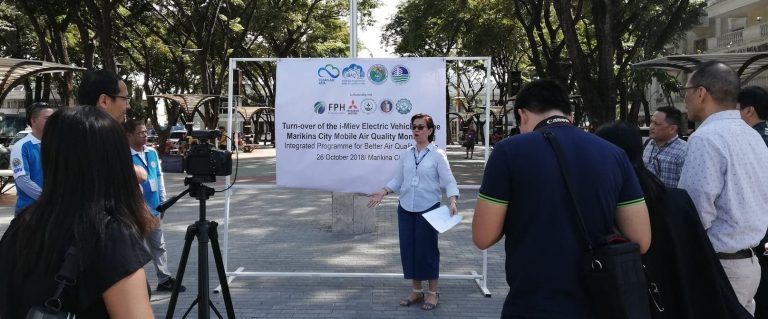Written from information provided by Clean Air Asia.
An electric vehicle fitted with mobile air sensing equipment became a familiar sight on the streets of Marikina City in Metro Manila late last year, as it hummed through the city recording detailed, street-level air quality.
The comprehensive citywide air quality monitoring boosted Marikina’s air quality monitoring capacity and baseline air pollution data, crucial information for Marikina’s upcoming Clean Air Action Plan, which the City is developing with Clean Air Asia’s Integrated Programme for Better Air Quality in Asia (IBAQ Programme). This initiative is conducted in collaboration with the Department of Environment and Natural Resources, First Philippine Holdings, Inc., Mitsubishi Motors Philippines, Inc., De La Salle University, Ateneo de Manila University, and the University of the Philippines.
According to Clean Air Asia and the city, the plan is being finalized with stakeholders, and will spell out targeted measured for emissions reductions when it is released in April 2019.
“This is a great opportunity for the city because we do not have the means to conduct such thorough emissions monitoring,” said Marikina City Environmental Officer Gloria Buenaventura.
One of the plan’s main activities is ambient air quality monitoring using mobile measurements to identify air pollution hotspots in the city; in this case, the mobile vehicle took a little over a month to establish baseline information through drives around Marikina along predetermined routes and at specified times.
The monitoring process identified hotspots of fine particulate matter (PM2.5) concentrations along the city’s main road network, generating a road pollution map of the city.
Together with the emissions inventory results and health benefits assessment using US EPA Environmental Benefits Mapping (BenMAP) software, all data collected go towards providing a holistic picture of the city’s air quality status, informing control measures that will be taken by the city.
It was an important attempt to better understand and reflect exposure levels for residents and vulnerable groups, providing detail to supplement measurements taken by the city’s stationary air quality monitoring station, and helping the city identify priority areas for pollution control.
“This is a good start for us to move towards clean air. We’re able to generate important data relating to air quality, and this will enable us to know how vulnerable our communities are when it comes to air pollution,” said Buenaventura.
“We hope this can help improve overall city planning, too,” said Clean Air Asia Director of Programs Alan Silayan.
Optical air-sensing equipment developed by Aclima was installed in the i-Miev electric vehicle on loan from the Philippine Department of Environment and Natural Resources (DENR) through Mitsubishi Motors Philippines Corporation.

The handover ceremony at Marikina City Hall involved local government and DENR officials, senior staff from Mitsubishi Motors Philippines, the First Philippine Holdings Corporation, and representatives from Clean Air Asia.
Mitsubishi Motors Philippines Corporation Vice-President Rene Lampano said the i-Miev, with a range of 156km, allowed Marikina City to accurately measure air quality.
“We requested the DENR to loan the i-Miev electric vehicle to Marikina City, and we believe it will help the city more effectively monitor and assess ambient air quality,” he said.
Clean Air Asia’s Alan Silayan noted that collaboration was at the heart of successful air quality monitoring.
“In all of our partnerships and projects, there is one thing we have found that really works, and that is collaboration; collaboration with the private sector, governments, NGOs, academia. I would like to acknowledge this collaboration, particularly the support that we have from Marikina City, and from the private sector and government partners. This will achieve much bigger results and, ultimately, we can bring what we have learned to other areas,” he said.
Read the original here.
Banner photo by Marikina City.